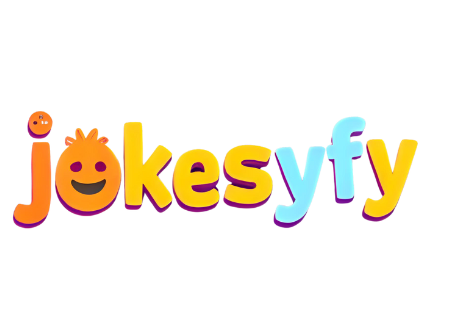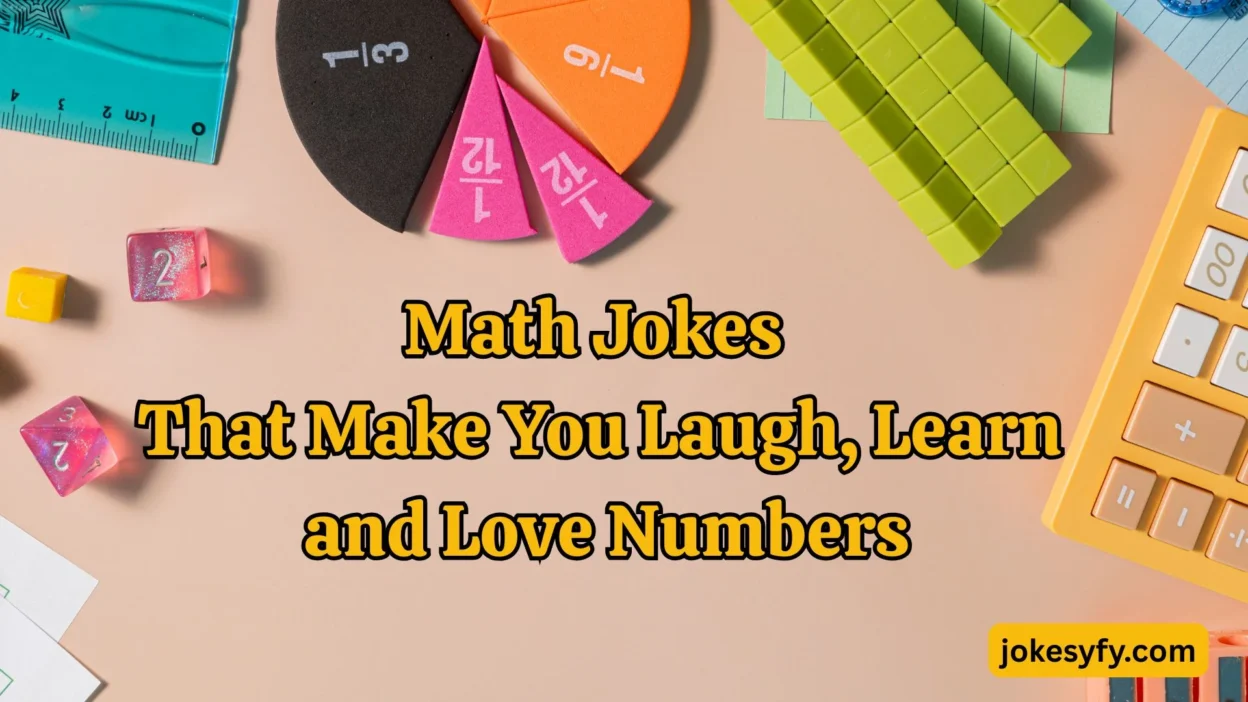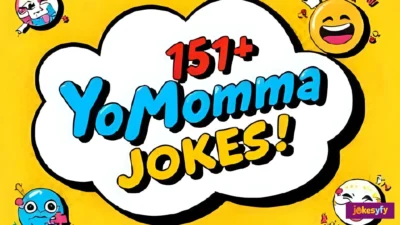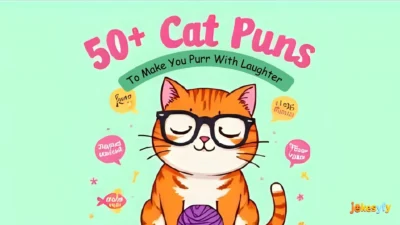Math is often seen as difficult, strict, and full of rules. But what if laughter could unlock the beauty hidden in numbers? That’s where math jokes come in. These clever puns, playful one-liners, and witty classroom comebacks show us that numbers don’t have to be scary—they can be funny, friendly, and full of joy 😄. Whether you’re a student facing formulas, a teacher trying to spark engagement, or just someone who enjoys clever wordplay, you’ll find plenty of smiles here.
In this article, you’ll explore inspiring jokes from beginner to advanced, discover why humor makes learning easier, and pick up creative ways to use these jokes in classrooms and family life. Let’s multiply the fun and divide the stress!
Why Math Jokes Can Change Your Mindset
- Humor in numbers helps break the fear of formulas and makes learning more approachable.
- A clever pun turns math into creativity instead of rigidity.
- Math jokes help students see mistakes as part of the fun, not as failures.
- Sharing laughter builds classroom community and reduces anxiety 😌.
- Jokes about algebra or geometry can spark curiosity in reluctant learners.
- Teachers who begin lessons with humor often notice more engagement.
- Laughter stimulates the brain, improving memory and retention.
- Even adults who “hate math” soften when hearing witty number humor.
- Humor shows math is everywhere—in words, objects, and life.
- Smiles make students more open to solving problems.
- Playful jokes about numbers help transform stress into confidence 💪.
- Funny math stories remind learners that nobody is alone in struggling.
- Joyful learning often lasts longer in the mind and heart.
- Humor can inspire a growth mindset: “I can try, I can laugh, I can learn.”
General & Beginner Humor You’ll Love
- Why was six afraid of seven? Because seven eight nine 😂.
- What did the zero say to the eight? “Nice belt!”
- Why was the math book sad? It had too many problems 📘.
- What do you call a number that can’t sit still? A roamin’ numeral.
- How do you make seven even? Remove the “s.”
- Why don’t calculators argue? They can always count on each other.
- Math jokes like “I’ve got problems” make learning relatable.
- Why was the equal sign so humble? It wasn’t less than or greater than anyone.
- What did one circle say to another? “You’re pointless.”
- Are monsters good at arithmetic? Only Count Dracula 🧛.
- What tool’s best for mathematics? Multi-pliers.
- Why did the student bring a ladder to math class? To reach higher levels.
- How do numbers stay fit? Constant exercise 🏃.
- Why do students love math parties? Because they’re full of functions.
- What’s a mathematician’s favorite snack? Pi chips.
Algebra, Equations, and Wordplay Delight
- Why did the quadratic equation go to the party? It had real roots.
- Why did the variable X break up with Y? Because Y kept changing 💔.
- What did the exponent say to the base? “You have potential.”
- Why do algebraists make great dancers? They know how to factor out moves.
- How does a mathematician plow a field? With a pro-tractor.
- Math jokes about polynomials: “Too many terms, let’s simplify.”
- What do you call friends who love the same equation? Alge-bros 🤝.
- Why did the student hate negative solutions? They were below the line.
- How do you comfort an equation? Remind it: “You’ll be solved soon.”
- What does “i” say to π? “Be real.”
- Why was the linear equation so confident? It knew its slope.
- Why do logs hate big bases? They feel overshadowed.
- Why did algebra books always stress? Too many variables.
- Why do quadratic equations always look tired? Too many squares 😴.
- What’s an algebraist’s favorite pet? A function-ing cat.
Geometry, Shapes & Visual Wit
- Why was the obtuse angle upset? Because it was never right.
- What do you call a polygon that gossips? A multi-side chat 🗣️.
- Why did the circle blush? It saw the tangent line.
- How do you apologize to a triangle? Say, “Sorry, I was obtuse.”
- What did one shape say to another? “You’re pointless.”
- Why do parallel lines have so much in common? Pity they’ll never meet 😢.
- Math jokes with squares: “I’ve got four right angles, deal with it.”
- Why do circles make bad comedians? They go in loops.
- Why was the triangle a great singer? It hit all the right notes 🎶.
- What’s a math student’s favorite city? Times Square.
- What did the line say to the circle? “You’re so well-rounded.”
- Why do geometry teachers love trees? Gee-I’m-a-tree 🌳.
- Why was the square popular? It had perfect sides.
- Why did the hexagon always host parties? Because it had six sides to share.
- Why do right angles never argue? They’re always correct ✅.
Fractions, Numbers & Clever Puns
- Why was the fraction worried? It was improper.
- What did the numerator say to the denominator? “You complete me ❤️.”
- Why don’t fractions argue? They find common ground.
- Why did the decimal feel lonely? It had no point.
- Math jokes with halves: “50% of the time, I’m right.”
- Why was 1 afraid of 2? Because they were prime enemies.
- Why did the integer go broke? It lost value 💸.
- Why did 7 eat 9? Because you’re supposed to eat 3 squared.
- Why is the equal sign calm? It doesn’t compare.
- How do mathematicians eat fruit? By picking whole numbers 🍏.
- Why was 10 afraid of 7? Because 7 8 9.
- Why did the number cross the road? To reach the other side of the equation.
- Why did the student bring a ruler to bed? To see how long they could sleep.
- Why do fractions love jokes? They’re always in parts.
- What’s the loneliest number? One 😔.
Trigonometry Fun & Sine-ful Humor
- Why did sin and cos break up? They needed space.
- What’s a trig student’s favorite dessert? Pi 🥧.
- Why did the triangle go to the doctor? It felt a bit sinus.
- Why don’t angles ever gossip? They keep it all in degrees.
- Math jokes with tan: “You’re looking acute today.”
- Why do trig students make good friends? They never go off on a tangent.
- Why was the circle tired? It had been around too long.
- What’s a math teacher’s favorite holiday? Pi Day 🎉.
- Why was the triangle proud? It had all the right angles.
- Why do sine waves love parties? They keep the vibe going 🎶.
- Why was tangent line nervous? It touched circles only once.
- What did sine say to cosine? “You complete my square.”
- Why was cotangent grumpy? Always divided attention.
- Why do triangles love jokes? They always find the right angle 😂.
- Why are trig books funny? They’re full of functions.
Calculus & Advanced Humor
- Why was the calculus student crying? It had too many limits.
- What did the derivative say? “I’m going off on a tangent.”
- Why was the integral so chill? It knew how to find its limits 🧘.
- What do mathematicians eat? Derivative soup.
- Why did the function break up? It couldn’t find continuity 💔.
- Math jokes about curves: “You’ve got a great slope.”
- Why are integrals lazy? They just sum things up.
- Why was the derivative so sharp? It always cut to the chase.
- Why do mathematicians like tea? It’s steeped ☕.
- Why was the equation shocked? It saw its derivative disappear.
- Why was calculus stressful? Too many changing variables.
- Why did the limit go to therapy? It had boundary issues 😅.
- Why was the curve confident? It had the right direction.
- Why did the series fail? It didn’t converge.
- Why are mathematicians calm? They always find solutions.
Classroom & Teacher Humor
- Why did the teacher wear glasses? To improve division 👓.
- Why do teachers love math jokes? They break the ice.
- Why was the classroom loud? Too many functions.
- What did the student say? “I have too many problems already.”
- Why was the homework sad? Nobody wanted to take it home.
- Why did the test look confident? It had all the answers.
- Math jokes in class encourage shy students to smile.
- Why did the student bring a pencil? To draw attention ✏️.
- Why are teachers like fractions? They simplify life.
- Why was the ruler strict? It drew the line.
- Why did the eraser feel proud? It made no mistakes.
- Why did the blackboard blush? It was wiped clean.
- Why are math teachers patient? They solve problems daily.
- Why did the bell ring happily? Class was over 🛎️.
- Why do students love punny teachers? They multiply joy.
- Math Jokes for Kids & Families
- Why was the child excited? It solved its first problem 🎉.
- What do you call a fish that loves numbers? A math-a-fish 🐟.
- Why was the candy good at math? It counted sugar.
- Why was the puppy smart? It could do tricks.
- Why do kids love Pi Day? Free pie 🥧.
- Math jokes make family game nights more fun.
- Why did the teddy bear do well? It was stuffed with answers.
- Why was bedtime funny? Parents counted sheep.
- Why did the toy calculator laugh? Buttons were tickled.
- Why was the Lego student clever? It added up bricks 🧱.
- Why was the balloon smart? It knew its volume 🎈.
- Why do parents love math humor? Kids learn while laughing.
- Why did the swing count? To keep balance.
- Why was the bicycle smart? It had two tires (two tiers).
- Why was the cookie funny? It was full of chips 🍪.
The Psychology of Humor in Learning
- Laughter reduces cortisol, lowering stress levels 😌.
- Smiling boosts dopamine, making memory stronger.
- Math jokes make the brain associate formulas with joy.
- Humor improves focus in classrooms.
- Happy learners are more motivated learners.
- Jokes create a safe space where mistakes aren’t punished.
- When parents use humor, children open up to learning faster.
- Teachers who use puns build stronger bonds with students.
- Humor bridges cultural and language gaps 🌍.
- Jokes make tough topics less intimidating.
- Repetition through humor helps retention.
- Group laughter strengthens community in class.
- Funny stories improve long-term memory of concepts.
- Positive emotion improves critical thinking.
- Humor transforms math from fearsome to fun 🎯.
Conclusion
At the end of the day, numbers aren’t just about equations—they’re about life, laughter, and connection. These math jokes remind us that learning can be joyful, lighthearted, and meaningful. Whether you’re in a classroom, at home with family, or sharing a pun with friends, let the smiles multiply and the stress divide 😊.

I am Charles K Baxter, a humor enthusiast passionate about spreading joy and positivity through laughter.




